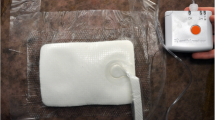Abstract
We report a modified technique of delayed primary wound closure using a wound wick. A rodent model was used to determine its influence on healing. After loose primary closure of two paravertebral incisions on the dorsum of male rats, a 10 cm length of ribbon gauze, soaked in either saline or 1% povidone-iodine, was inserted into the right sided wound. Wicks were soaked daily with the same solution until removal on the third post-operative day. The inclusion of a wick soaked in saline had an early transient effect on healing. A more prolonged impairment of healing was demonstrated in povidone-iodine wicked wounds and their respective controls. These data suggest that povidone-iodine impaired healing not only in the wicked wound, but also inhibited healing in the adjacent unwicked wound which was not directly exposed to the antiseptic. The observed delay in healing in povidone-iodine wicked wounds must however be balanced against its beneficial effect on wound infection rates. We suggest that further evaluation of this method of closure in contaminated wounds is warranted.
Similar content being viewed by others
References
Foster, G. E., Bourke, J. Bolwell, J., et al. Clinical and economic consequences of wound sepsis after appendicectomy and their modification by metronidazole or povidoneiodine. Lancet 1981; 1:769–71.
Krukowski, Z. H., Irwin, S. T., Denholm, S., Matheson, N. A. Preventing wound infection after appendicectomy: a review. Br. J. Surg. 1988; 75:1023–33.
Galland, R. Heine, K. J., Trachtenberg, L. S., Polk, H. C., Reduction of surgical wound infection rates in contaminated wounds treated with antiseptics combined with systemic antibiotics: An experimental study. Surgery 1982; 91:329–32.
Zamora J. L. Povidone and wound infection. Surgery 1984; 1:121–122.
Gingold, S., Berardis, J., Knight, P. Reducing the risk of wound infection in operations upon the colon. Surg. Gynecol. Obstet. 1984; 158:9–12.
Borden, E. B., Sammartano, R. J., Dembe, C., Boley, S. J. The effect of metronidazole on wound healing in rats. Surg. 1985; 97:331–5.
Viljanto, J. Disinfection of surgical wounds without inhibition of normal wound healing. Arch Surg. 1980; 115:253–6.
Gilmore, O. J. A. A reappraisal of the use of antiseptics in surgical practice. Ann. Royal Coll. Surg. Eng. 1977; 59:93–102.
Bergamini, T. M., Lament, P. M., Cheadle, W. G., Polk, H. Combined topical and systemic prophylaxis in experimental wound infection. Am. J. Surg. 1984; 147:753–6.
Walsh, J. ?., Watts, J. M., McDonald, P. J., et al. The effect of topical-iodineon the incidence of infection in surgical wounds. Br.J. Surg. 1981;68:185–9.
Brennan, S. S., Leaper, D. J. The effect of antiseptics on the healing wound; a study using the rat ear chamber. Br. J. Surg. 1985; 72:780–2.
Lineaweaver, W., McMorris, S., Soucy, D., Howard, R. Cellular and bacterial toxicities of topical antimicrobials. Plast. Reconstr. Surg. 1985; 75:394–6.
Lineaweaver, W., Howard, R., Soucy, D.,et al. Topical antimicrobial toxicity. Arch Surg. 1985; 120:267–70.
Sanchez, I. R., Swaim, S. F., Nusbaum, K. E.,et al. Effects of Chlorhexidine diacetate and povidone-iodine on wound healing in dogs. Vet. Surg. 1988; 17:291–5.
Mulliken, J. Healy, N. A., Glowacki, J. Povidone-iodine and tensile strength of wounds in rats. J. Trauma 1980; 20:323–4.
Mertz, P. M., Alvarez, O. M., Smerbeck, R. V., Eaglstein, W. H. A new in vivo model for the evaluation of topical antiseptics on superficial wounds. The effect of 70% alcohol and povidoneiodine solution. Arch Dermatol. 1984; 120:58–62.
Aronoff, G. R., Friedman, S. J., Doedens, D. J., Lavelle, K. J. Increased serum iodide concentration from iodine absorption through wounds treated topically with povidone-iodine. Am. J. Med. Sci. 1980; 279: 173–6.
Author information
Authors and Affiliations
Rights and permissions
About this article
Cite this article
Molloy, R.G., Brady, M.P. A modified technique of delayed primary closure using a povidone iodine wick: Influence on wound healing in an experimental model. I.J.M.S. 162, 297–300 (1993). https://doi.org/10.1007/BF02960723
Issue Date:
DOI: https://doi.org/10.1007/BF02960723




